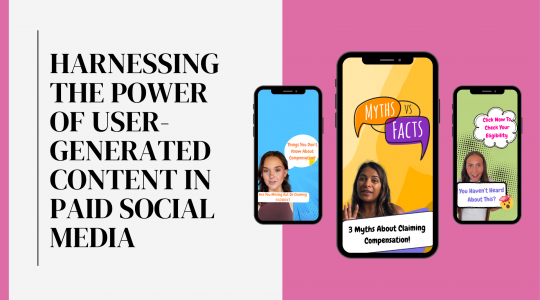Harnessing the power of User-Generated Content (UGC) in paid social media
In the continuously evolving landscape of digital marketing, it’s essential that we remain in touch with how our audience consumes information.
We investigated the topic of paid user generated content (often abbreviated to paid UGC) and spoke to our Paid Social Executive, Libbigail Evans to find out more about how it’s grown to become an integral way we connect with our audience.
What is user generated content (UGC)?
As social media use has become a major part of our daily lives (with usage almost tripling over the past ten years), companies must consistently review their marketing approach to ensure they’re in tune with the latest trends.
One key way we’re connecting with customers is through paid UGC.
To understand this, we first need to explain the definition of organic UGC.
Organic UGC is any content – text, images, videos, reviews, testimonials, or other media which is created by individuals rather than brands or social media platforms themselves.
When a company pays for this content to be produced by these individuals, it then becomes paid UGC.
If you think this sounds a lot like influencer marketing, you’re not a million miles away.
To put it simply:
Paid UGC is where the individual is paid and then produces content on behalf of the brand or company who have paid them.
Influencer content typically includes a budget for a creator to promote or sponsor the post using their own audience. These creators might never have a real or authentic interaction with the brand, and the justification of using these creators is often based on their following alone.
This is why paid UGC content is such a powerful way for marketers to raise brand awareness and improve conversion rates. It can have a much more authentic, relatable, and organic feel than content from influencers or content hailing from a brand directly, making it an invaluable asset for law firms looking to establish trust and rapport with their clients, usually for a fraction of the production cost.
The evolution of paid UGC
Paid UGC content gained prominence with the emergence of social media networks like Facebook, Twitter, and Instagram, where users would share their thoughts and experiences about products and services. This is when e-commerce brands quickly noticed the impact real customers leaving positive (or negative!) reviews and endorsements for their products had on their sales and then contacted users to pay them to create organic content.
It has since progressed to encompass new platforms. With the advent of more visual-oriented platforms like Instagram and more recently TikTok, the best performing styles of paid UGC content has changed, with short form video harbouring the best results, following in the footsteps of organic social media.
It’s also spread far beyond e-commerce as companies recognise the benefits of UGC advertising services as well as products.
The drawbacks of using paid UGC content
While we reap the benefits of better targeting by analysing the content our users create, humanise our brand by showcasing experiences and stories of real users and reach an audience who otherwise may not interact with our company, we also need to be aware of the potential drawbacks of using paid UGC.
Lack of control over a brands image and messaging, variability in quality of output, and users not adhering to time constraints all play into an overall lack of control when compared with creating inhouse content.
This is coupled with the risk that the pool of creators within industries like the lead generation sector can be that small that competitors may utilise the same individuals for their content.
All of this highlights just how crucial it is for us to have a strong relationship with a carefully selected set of creators to minimise these risks.
Blume’s approach
We asked Libbigail Evans, our Paid Social Executive about our approach here at Blume, here’s what she had to say:
“Bringing UGC into the legal lead generation industry has certainly been an interesting one!
“We began by using very basic styles visually, usually asking a creator to talk to their phones in selfie-style videos so that our audience would feel familiar with the user. We were really impressed with the results, which generated far more leads than using solely static imagery.
“Since then, we’ve been able to create a clear structure to our videos, where we ask users to utilise a bank of hooks which we’ve identified as performing particularly well and keep users retained for longer than 4 seconds.
“We also keep a keen eye on viral trends to ensure our content remains fresh and relevant, so the end consumer doesn’t tire of seeing repeated ads.
“It’s also an incredibly cost-effective approach to producing content – to film in this more authentic style we don’t need a lot of the more professional editing software or flashy cameras which are more common for business created content.”
Conclusion
UGC has become an essential part of marketing strategies across various industries including the legal sector, its authenticity, engagement potential, and cost-effectiveness offer a distinct opportunity for law firms to build trust with their audience.
With more companies recognising the potential of UGC, and platforms like TikTok continuing to expand and lead the way with this style of content, the time for the legal industry to act is now.
Working with Blume
Blume is committed to helping law firms plan attract the right clients through a combination of digital marketing, tech and data. We monitor trends closely, making sure our knowledge articles contain all the information needed to keep you up to date with these developments, as they happen.




